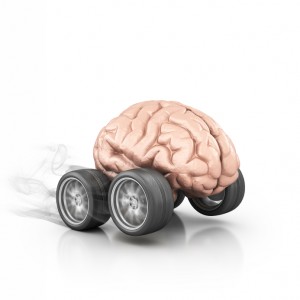Aristotle, Cyberpunk, and Extended Minds

How far does it go?
Aristotle argued against teaching people to read. If we can store our memories externally, he argued, we won’t need to store them internally, and that would be a tragic loss. We’ll stop training our brains. We’ll forget how to remember.
Aristotle was right, of course. Except for a few “memory athletes”, we no longer train our brains to remember. And our plastic brains may well have changed because of it. The brain of a Greek orator, trained in advanced memory techniques, was probably structurally different from our modern brains. What we learn (or don’t learn) shapes our physical brains.
Becoming literate was one step in a long journey to externalize our minds. Today, we call it the “extended mind” based on a 1998 paper by the philosophers Andy Clark and David Chalmers. Clark and Chalmers ask the simple question: “Where does our mind stop and the rest of the world begin?” The answer, they suggest, is “… active externalism, based on the active role of the environment in driving cognitive processes.”
If our minds extend beyond our skulls, where do they stop? I see at least three answers.
First, the mind extends throughout the rest of the body. As we’ve seen with embodied cognition, we think with our bodies as much as our brains. The physical brain is within our skulls but the mind seems to encompass our entire body.
Second, our minds extend to other people. We know that the people around us affect our behavior. (My mother warned me against running with a fast crowd). It turns out that other people affect our thoughts as well, in direct and physical ways.
The physical mechanism for “thought transfer” is the mirror neuron – “…a neuron that fires both when an animal acts and when the animal observes the same action performed by another.” When we see another person do something, our mirror neurons imitate the same behavior. Other people’s actions and moods affect our thoughts. We can – and do –read minds.
The impact of our mirror neurons varies from person to person. The radio show Invisibilia recently profiled a woman who could barely leave her own home so affected was she by other people’s thoughts. (You can find the podcast, called Entanglement, here). The woman was so entangled with others that it’s nearly impossible to draw a line between one mind and another. Perhaps we’re all entangled – each brain is like a synapse in a much larger brain.
Third, we can extend our minds through our external devices. We now have many ways to externalize our memories and, perhaps, even our entire personas. In Neuromancer, the novel that launched the cyberpunk wave, people save their entire personalities and memories on cassette tapes. (How quaint). They extend their minds not only spatially but also into the future.
Neuromancer is about the future, of course. What about today’s devices … and, especially, the world’s most popular device, the smartphone? As we extend our minds through smartphones, do we reduce the “amount of mind” that remains within us? Do smartphones make us dumb? Or, conversely, do they increase the total intelligence availability to humanity – some of it in our brains and bodies and some of it in our external devices?
Good questions. Let’s talk about them tomorrow.
Happiness and High Dudgeon

I’m always happy!
Some years ago, I discovered that I could improve my mood (and maybe my performance) simply by forcing myself to smile. I knew that being happy made me smile. I wondered if smiling could make me happy. Happily, it could.
As we’ve discussed before (here and here), the body and the brain are one system. The brain affects the body and the body returns the favor. Your posture affects your thoughts and your mood. According to Amy Cuddy, it can even help you get a job.
In fact, you don’t even have to smile. Just hold a pencil in your mouth sideways. Your smile muscles will flex and your mood will lift. Even though you know you’re tricking yourself, it actually works. Indeed, it’s foolproof.
When I discovered all this, I thought, “Great. I can always be happy. I’ll never be cranky or curmudgeonly again. I’ll always be in a good mood.”
But something funny happened on the way to happiness nirvana. I discovered that, on many occasions, I simply didn’t want to smile. I found that I actually enjoyed being cranky, snarky, and even a tad self-righteous.
This was a revelation. I’m a reasonably positive person and I always assumed that – if I had the choice – I would opt for happiness rather than its opposite. But I do have a choice and I find that I don’t always exercise it.
The dilemma seems to be the difference between being right and being happy. When I know I’m right – and somebody else is wrong – I can work myself into high dudgeon (as my mother called it). It’s a sense of self-righteous anger. I know I’m right and I want to prove the other side wrong. I’m indignant. I want to expose them for what they are – craven fools. My self-righteousness fuels the fire. I have no time to be happy. I’m on a mission.
I also enjoy winning, whether it’s an argument or a race or a poker hand. In a roundabout way, then, high dudgeon can lead to happiness. My indignation provides the energy and determination that can power me to victory. And victory makes me happy.
Getting angry to get happy, however, is a very odd dynamic. You’re going the wrong way. And winning one victory can simply lead to another battle. If there’s a victor, there’s also a vanquished. And he wants to get even.
I promised to write about happiness. First, I want to explore this conundrum of happiness and high dudgeon. Think about it. Do you actually want to be happy? Or, put another way, if you had to choose, would you rather be happy or right?